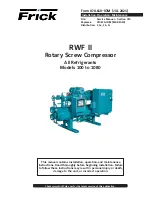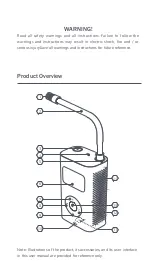
070.610-IOM (JUL 21)
Page 11
RWF II Rotary Screw Compressor Units
Installation
Figure 11: Dual dip tube
The
level-control method (see
) uses a
float level
control on the receiver to close a
solenoid valve feeding
the evaporator when the liquid falls below that amount
necessary for 5 min of
liquid injection oil cooling.
Figure 12: Level control
Table 6: Liquid line size and receiver volume
Refrigerant RWF II
model
Min.
line
size*
Max.
Lbm/
min
5 min supply
Heat load
lb
ft
3
kBtu/hr TR
R-717
high
stage
100-134
0.75
16.0
80
2.2
506
42
177-270
1
32.0
160
4.4
1016
85
316-399 1.25
46.6
233
6.3
1478
123
480-546
1.25
63.8
319
8.7
2022
169
676
1.25
82.4
412
11.2
2613
218
856
1.5
105.2
526
14.3
3335
278
R-717
Booster
100-134 0.5
2.6
13
0.4
85
7
177-270
0.5
4.9
25
0.7
162
14
316-399 0.5
7.2
36
1.0
237
20
480-546 0.75
9.9
50
1.3
326
27
676
0.75
12.6
63
1.7
414
35
856
0.75
16.2
81
2.2
531
44
1080
1
21.0
105
2.9
688
57
R-507
†
high
stage
100-134 1.25
51.3
257
4.1
221
18
177-270
1.5
102.6
513
8.3
441
37
316-399 1.5
149.0
745
12.0
641
53
480-546
2
203.8
1019
16.4
877
73
676
2
266.9
1335
21.5
1149
96
856
2
269.4
1347
21.7
1159
97
R-507
†
Booster
100-134 0.5
8.7
44
0.7
41
3
177-270 0.75
14.7
74
1.2
68
6
316-399
0.75
21.4
107
1.7
99
8
480-546
1
29.3
147
2.4
136
11
676
1
42.1
211
3.4
196
16
856
0.75
9.6
48
0.8
45
4
Conditions:
HI Stage: 0°F Evap, and 95°F Cond, 10°F suc
-
tion (line) superheat; Booster: -40°F Evap, 95°F Cond and
20°F Intermediate, 10°F suction (line) superheat
* Based on 100 foot liquid line. For longer runs, increase line
size accordingly.
†
Unloaded slide valve.
Water or glycol oil cooling -
optional
The plate-and-shell type water or glycol oil cooler is
mounted on the unit complete with all oil piping. The
customer must supply adequate water connections. De-
termine the size of the oil cooler supplied with the unit,
as outlined on the Frick P&I diagram and general arrange
-
ment drawings.
The water or glycol supply must be
sufficient to meet the required flow.
The glycol or water entering temperature should be no
lower than 60°F.
A closed-loop system is recommended for the water or
glycol side of the oil cooler. Careful attention to
water
treatment is essential to ensure adequate life of the cooler
if
cooling tower water is used.
It is imperative that the
condition of cooling water or
glycol closed-loop fluids be
analyzed regularly and as necessary and maintained at a
pH of 7.4, but not less than 6.0 for proper heat exchanger
life.
After initial start-up of the compressor package, the
strainer at the inlet of the oil cooler should be cleaned sev-
eral times in the first 24 hours of operation.
In some applications, the plate and shell oil cooler may
be subjected to severe water conditions, including high
temperature and/or hard water conditions. This causes
accelerated
scaling rates which will penalize the perfor
-
mance of the heat exchanger. A chemical cleaning process
will extend the life of the plate-and-shell heat exchanger.
It is important to establish regular cleaning schedules.
Cleaning:
A 3% solution of phosphoric or oxalic acid is
suggested. You can obtain other cleaning solutions from
your local distributor, but they must be suitable for stain-
less steel. It is possible to clean the oil cooler in place by
back flushing with suggested solution for approximately
30 min. After back flushing, rinse the heat exchanger with
fresh water to remove any remaining cleaning solution.
High-stage economizer - optional
The economizer option provides an increase in system
capacity and efficiency by subcooling liquid from the
condenser through a heat exchanger or flash tank before
it goes to the evapora tor. The subcooling is provided by
flashing liquid in the economizer cooler to an intermediate
pressure level. The intermediate pressure is provided by a
port located part way down the compres sion process on
the screw compressor.
As the screw compressor unloads, the economizer port
will drop in pressure level, eventually being fully open to
suction. Because of this, an output from the
microproces-
sor is generally used to turn off the supply of flashing
liquid on a shell and coil or DX economizer when the
capacity falls below approximately 60% to 70% capacity
(85% to 90% slide valve position). This is done because
the compressor will be more efficient operating at a higher
slide valve position with the economizer turned off, than
it will at a low slide valve position with the economizer
turned on. Please note however that shell and coil and DX
economizers can be used at low compressor capaciti es in
cases where efficien cy is not as important as assuring that
the liquid supply is subcooled. In such cases, the economi-
zer liquid solenoid can be left open whenever the com-
pressor is running.












































